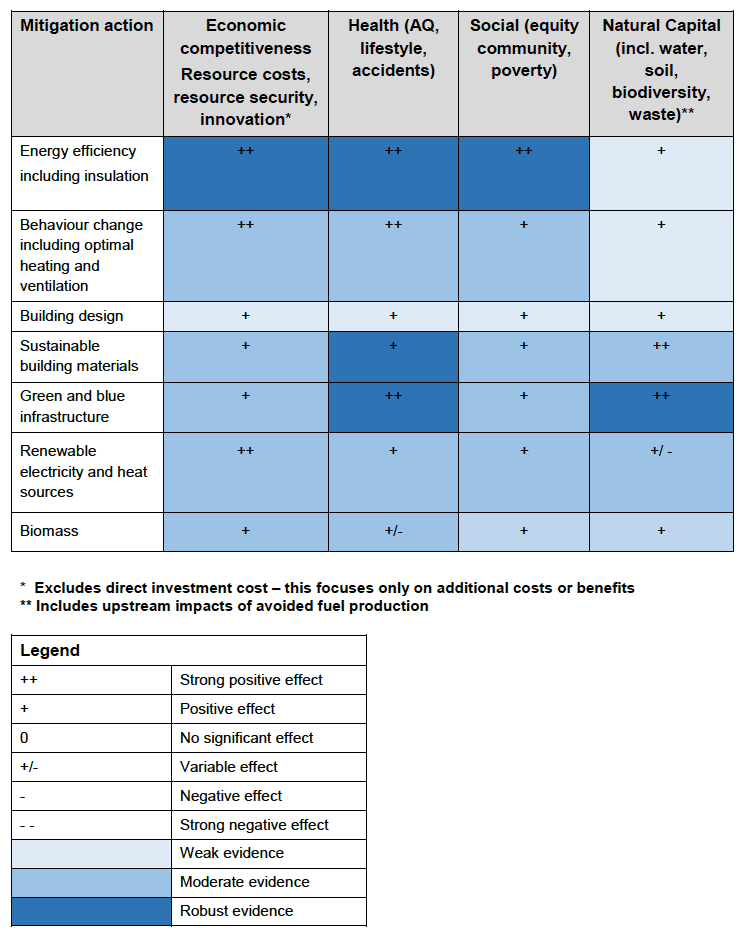Climate change: evidence review of mitigation options in the Built Environment sector
Evidence review of potential climate change mitigation measures in the Built Environment sector.
3 Overview of results
This Chapter provides an overview of the direction and magnitude of impacts under the shift, reduce, avoid framework, this is complemented by a summary table, and outcomes are then framed within the research questions identified in Section 1.3.
3.1 Direction and magnitude of impacts
Avoid: reduce energy demand
- Insulation and other building fabric improvements. There is a rich established evidence base on the introduction of building energy efficiency measures including wall, floor and roof insulation; air-tightness; lagging of pipes and boilers; and double or triple-glazed windows. Co-benefits include health and well-being improvements from improved thermal comfort and reduced dampness and mould, as well as fuel cost savings. Although these cost savings may result in the uptake of more carbon intensive behaviours or increased consumption (rebound effect). A key benefit is that reductions in fuel poverty may occur. Productivity associated with commercial buildings can be significantly improved, which can have considerable economic benefits.
- Insulation in existing buildings can be improved through retrofitting, which can generate local socio-economic benefits. Retrofitting is the process of refurbishing the existing housing stock, for example, by fitting energy efficiency measures such as insulation.
- It is cost-effective to ensure that new buildings are as energy-efficient as possible. Building standards for energy efficiency will influence the sustainability of buildings constructed in Scotland for decades to come, with new buildings representing ~ 1% of the building stock each year. Care must be taken to ensure that adequate ventilation is provided in air-tight buildings, to avoid build-up of radon and other indoor air pollutants.
- Behaviour change in the built environment sector, such as turning down the thermostat and turning off unused lights and appliances, can achieve significant carbon savings in the short term, unlike infrastructure development with timescales ranging from years to decades. Benefits include consumer fuel cost savings. Behaviour change can be facilitated in several ways, such as through price incentives or information provision e.g. through the introduction of smart metering.
Shift: a more sustainable built environment
- Use of more sustainable building materials such as timber, and ensuring end-of-life re-use of materials, can provide co-benefits by reducing the overall life cycle impact of buildings. This is consistent with a circular economy approach to building materials and waste arising from the construction and demolition of buildings. Co-benefits include avoided environmental damage from the extraction, processing and manufacture of high carbon building materials such as steel, bricks and concrete, e.g. the land use impacts and reduced air and water pollution arising from quarrying, mining and smelting.
- Building regulations can be used to promote the use of sustainable building materials, as well as being used in the more familiar way to enforce energy efficiency standards (see below).
- In the Scottish context, there are opportunities for production and diversification of forestry and agricultural co-products such as timber for construction and sheep's wool for insulation, which can lead to socio-economic co-benefits for rural economies.
- Green infrastructure such as green roofs and walls can provide insulation, reducing heat demand during cold periods, and cooling, reducing the need for air conditioning during heat waves. Trees close to buildings can also provide shade and shelter, and parks, gardens and water features help to provide urban cooling on hot days. Co-benefits include positive impacts on biodiversity and urban wildlife, aesthetic value, places for outdoor recreation, reduced storm-water runoff, air and water quality improvements and carbon sequestration. Planning regulations can be used to promote green infrastructure, e.g. by specifying the amount of green space that should be included in new developments, and encouraging multifunctional green infrastructure such as green roofs.
Improve: low carbon energy options
- Adoption of low carbon energy sources such as solar panels can lead to air quality co-benefits from avoided fossil fuel emissions and energy security benefits. However, there could be adverse side-effects from the adoption of biomass for heating (if biomass replaces gas in urban areas), unless combustion emissions are controlled or a targeted approach is used. Biomass also needs to be from a sustainable source - to minimise potential negative impacts on biodiversity and soil fertility that can occur.
Magnitude of impacts
Several studies conclude that the magnitude of the co-benefits outweighs potential adverse side effects in the built environment sector ( e.g. Clarke et al., 2014). Modelling studies conclude that for home energy efficiency, the health benefits arising from increased thermal comfort outweigh the risks associated with deteriorating indoor air quality such as the accumulation of radon, and that such risks can be mitigated through the adoption of improved ventilation (Vardoulakis et al., 2015; Wilkinson et al., 2009). A major study of the multiple benefits of energy efficiency by the IEA concluded that health improvements from warmer buildings in cost-benefit analyses can result in cost-benefit ratios of up to 4:1, and the value of industrial productivity and operational benefits can be up to 2.5 times greater than the value of energy savings ( IEA, 2014).
A qualitative summary is provided below in Table 3.1 which sets out the direction and magnitude of impacts for the different mitigation actions with the rationale covered in the following Chapters.
Table 3‑1. Magnitude and direction of co-impacts in the built environment

Weak evidence relates to there being limited evidence currently available or that the available evidence is less robust. Robust evidence relates to stronger evidence base relating to the quality of and number of papers.
Contact
Email: Debbie Sagar
There is a problem
Thanks for your feedback